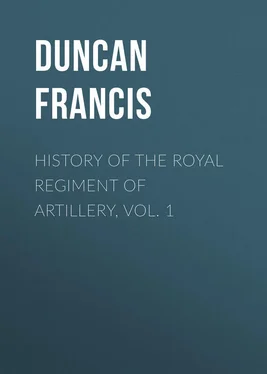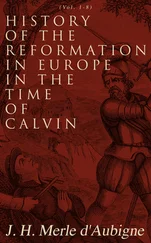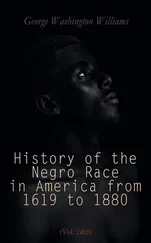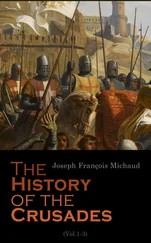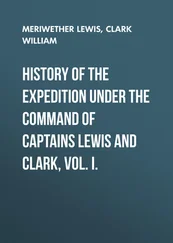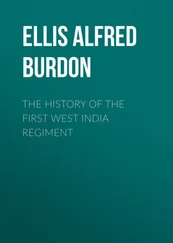Francis Duncan - History of the Royal Regiment of Artillery, Vol. 1
Здесь есть возможность читать онлайн «Francis Duncan - History of the Royal Regiment of Artillery, Vol. 1» — ознакомительный отрывок электронной книги совершенно бесплатно, а после прочтения отрывка купить полную версию. В некоторых случаях можно слушать аудио, скачать через торрент в формате fb2 и присутствует краткое содержание. Жанр: foreign_antique, foreign_prose, на английском языке. Описание произведения, (предисловие) а так же отзывы посетителей доступны на портале библиотеки ЛибКат.
- Название:History of the Royal Regiment of Artillery, Vol. 1
- Автор:
- Жанр:
- Год:неизвестен
- ISBN:нет данных
- Рейтинг книги:4 / 5. Голосов: 1
-
Избранное:Добавить в избранное
- Отзывы:
-
Ваша оценка:
- 80
- 1
- 2
- 3
- 4
- 5
History of the Royal Regiment of Artillery, Vol. 1: краткое содержание, описание и аннотация
Предлагаем к чтению аннотацию, описание, краткое содержание или предисловие (зависит от того, что написал сам автор книги «History of the Royal Regiment of Artillery, Vol. 1»). Если вы не нашли необходимую информацию о книге — напишите в комментариях, мы постараемся отыскать её.
History of the Royal Regiment of Artillery, Vol. 1 — читать онлайн ознакомительный отрывок
Ниже представлен текст книги, разбитый по страницам. Система сохранения места последней прочитанной страницы, позволяет с удобством читать онлайн бесплатно книгу «History of the Royal Regiment of Artillery, Vol. 1», без необходимости каждый раз заново искать на чём Вы остановились. Поставьте закладку, и сможете в любой момент перейти на страницу, на которой закончили чтение.
Интервал:
Закладка:
The most recent list of these distinguished officials is that published in Kane's 'List of Officers of the Royal Artillery.' In it all the Masters before the reign of Henry VIII. are ignored, as being merely commanders of the Artillery on expeditions or in districts. But this seems somewhat stern ruling. Undoubtedly Henry VIII. reorganized the Ordnance Department, and defined the position of the Master, as never had been done before, and the sequence of the Masters from his reign is clear and intelligible. But before his time there were not merely Masters of the Ordnance on particular expeditions, but also for life; and there were certainly Offices of the Ordnance in the Tower. It has, therefore, been thought advisable in the following list to prefix a few names, which seem deserving of being included, although omitted in 'Kane's List.'
The earliest of whom there is any record is
Rauf Bigod, who was appointed on 2nd June, 1483, "for life." His life does not, however, seem to have been a very long one, for we find
Sir Richard Gyleford, who was appointed in 1485.
Sir Sampson Norton was undoubtedly Master of the Ordnance, appointed in 1513, as has been proved by extant MSS.
The next one about whom there is any certainty would appear to be the one who heads 'Kane's List' —
Sir Thomas Seymour, who was appointed about 1537. Other lists show Sir Christopher Morris as Master at this time; but there seems little doubt that he was merely Lieutenant of the Ordnance, although a distinguished soldier, and frequently in command of the Artillery on service.
If one may credit 'Dugdale's Baronage,' the next in order was
Sir Thomas Darcie (afterwards Baron Darcie), appointed in 1545: but if so, he merely held it for a short time, for we find him succeeded by
Sir Philip Hoby, who was appointed in 1548.
'Grose's List' and others interpolate Sir Francis Fleming, as having been appointed in 1547; but this is undoubtedly an error, and his name wisely rejected by the author of 'Kane's List,' where it is placed, as it should be, in the list of Lieutenants of the Ordnance. There is a folio of Ordnance accounts still in existence, extending over the period between 29th March, 1547, and the last day of June, 1553, signed by Sir Francis Fleming, as Lieutenant of the Ordnance.
The next in rotation in the best lists is
Sir Richard Southwell, Knight, shown by 'Kane's List' as appointed in February, 1554, and, by certain indentures and Ordnance accounts which are still extant, as being Master of the Ordnance, certainly in 1557 and 1558.
The next Master held the appointment for many years. He was
Ambrose Dudley, Earl of Warwick, and can be proved from indentures in the possession of the late Craven Ord, Esq., which are probably still in existence, and from which extracts were made in 1820 by the compiler of a manuscript now in the Royal Artillery Library, to have been appointed on the 19th February, 1559, and to have held the office until 21st February, 1589, over thirty years.
Possibly owing to the difficulty of finding any one ready to undertake the duties of one who had had so much experience – a difficulty which occurred more than once again – the office was placed in commission after 1589, probably until 1596. From 'Burghleigh's State Papers' we learn that the Commissioners were, the Lord Treasurer, the Lord High Admiral, the Lord Chamberlain, and Vice-Chamberlain Sir J. Fortescue.
On 19th March, 1596, Robert, Earl of Essex, was appointed Master of the Ordnance, and held the appointment until removed by Elizabeth, in 1600. No record of a successor occurs until the 10th September, 1603, when
Charles, Earl of Devonshire, was appointed. He died in 1606, and was succeeded by
Lord Carew, appointed Master-General throughout England, for life, in 1608. He was created Earl of Totnes in 1625, and died in 1629. From a number of Ordnance warrants and letters still extant, there can be no doubt that he held the office until his death. For a year after, until 5th March, 1630, we learn, from the Harleian Manuscripts, that there was no Master-General. On that date
Howard Lord Vere was appointed, and held office until the 2nd September, 1634, when
Mountjoy, Earl of Newport, was appointed.
Then came the troubles in England – the Revolution, the Commonwealth, and at last the Restoration. Lord Newport seems to have remained Master-General the whole time; for on Charles II. coming to the throne, he issued directions specifying, "Forasmuch as the Earl of Newport may, by Letters Patent from our Royal Father, pretend to the office of our Ordnance, We, for weighty reasons, think fit to suspend him from said charge, or anything belonging thereto; and Our Will is that you prepare the usual Bill for his suspension."
On the 22nd January, 1660, a most able Master-General was appointed, whose place the King afterwards found it most difficult to fill. He was
Sir William Compton, Knight, and he remained in office until his death. By letters patent, on the 21st October, 1664, specifying that he had not determined with himself to supply the place of office of his Master of the Ordnance, then void by the death of Sir William Compton, and considering the importance of his affairs at that time to have that service well provided for, the King appointed as Commissioners to execute the office of Master of the Ordnance
John, Lord Berkly of Stratton, }
Sir John Duncombe, Knight, and }
Thomas Chicheley. }
This Commission lasted until the 4th June, 1670, when the last-named Commissioner (now Sir Thomas Chicheley, Knight), was appointed Master of the Ordnance, and in the warrant for his appointment, which is now in the Tower Library, there is a recapitulation of the names of previous Masters, which includes one – placed between Sir Richard Southwell and the Earl of Essex – which does not appear in any other list, but which one would gladly see included —
Sir Philip Sidney.
After the death of Sir Thomas Chicheley, the office was again placed in Commission, the incumbents being
Sir John Chicheley, son of the late Master,
Sir William Hickman, and
Sir Christopher Musgrave, the last-named of whom afterwards became Lieutenant-General of the Ordnance. This Commission lasted from 1679 to 8th January, 1682, when the celebrated
"George, Lord Dartmouth," became Master, having held the office of Lieutenant-General under the Commission from 1st July, 1679, as plain Colonel George Legge. He remained in office until after the Revolution of 1688, when he forfeited it for his adherence to the King. His successor, appointed by William III. in 1689, and afterwards killed at the Battle of the Boyne, rejoiced in the following sounding titles:
Frederick, Duke de Schomberg, Marquis of Harwich, Earl of Brentford, Baron of Teys, General of their Majesties' Forces, Master-General of their Majesties' Ordnance, Knight of the Most Noble Order of the Garter, Count of the Holy Roman Empire, Grandee of Portugal, General of the Duke of Brandenburg's forces, and Stadtholder of Prussia.
After his death, the Master-Generalship remained vacant until July, 1693, when it was conferred upon
Henry, Viscount Sidney, afterwards Earl of Romney, who held it until 1702. He was succeeded, almost immediately on Queen Anne's accession, by her favourite, the great
John, Earl of Marlborough, who held the appointment until he fell into disgrace with the Queen, when he resigned it, with his other appointments, on 30th December, 1711. He was succeeded by
Richard, Earl Rivers, who, after six months, was followed, on 29th August, 1712, according to the British Chronologist, or on the 1st July, 1712, according to Kane's List, by
James, Duke of Hamilton, who was killed in a duel in November of the same year.
Читать дальшеИнтервал:
Закладка:
Похожие книги на «History of the Royal Regiment of Artillery, Vol. 1»
Представляем Вашему вниманию похожие книги на «History of the Royal Regiment of Artillery, Vol. 1» списком для выбора. Мы отобрали схожую по названию и смыслу литературу в надежде предоставить читателям больше вариантов отыскать новые, интересные, ещё непрочитанные произведения.
Обсуждение, отзывы о книге «History of the Royal Regiment of Artillery, Vol. 1» и просто собственные мнения читателей. Оставьте ваши комментарии, напишите, что Вы думаете о произведении, его смысле или главных героях. Укажите что конкретно понравилось, а что нет, и почему Вы так считаете.
